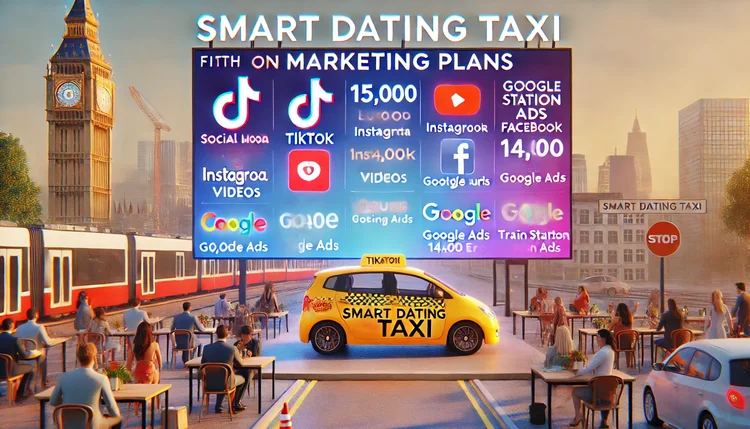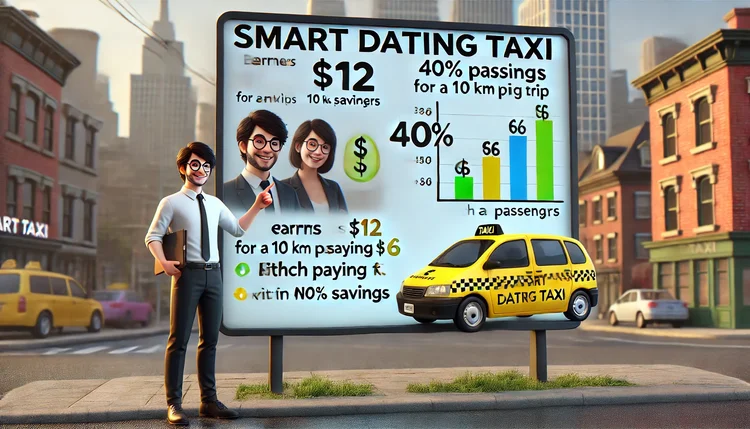Mobile Application
1. Introduction
The dating industry has undergone significant changes with the development of technology. Traditional methods are being complemented, and in some cases, replaced by online platforms that facilitate meetings and connections. However, these online platforms often lack the personal touch and spontaneity of face-to-face interactions. The "Smart Dating in Taxis" project aims to fill this gap by leveraging the convenience of taxi rides for dating purposes.
2. Background
In recent years, online dating platforms have gained immense popularity. According to the latest statistics, a significant portion of relationships now begin online. Despite this, many users express dissatisfaction with the lack of personal interaction and the time-consuming nature of these platforms. Additionally, urban professionals often find it difficult to make time for social activities due to their busy schedules. The "Smart Dating in Taxis" project is designed to address these issues by integrating dating with daily commutes.

3. Market Analysis
The online dating services market is steadily growing. According to recent reports, the global online dating market is expected to reach $9.2 billion by 2025, with an annual growth rate of 4.7%. This growth is driven by the increasing penetration of smartphones, busy lifestyles, and the acceptance of online platforms as a legitimate way to meet partners.
3.1 Target Market
The target market for the "Smart Dating in Taxis" service includes:
Urban professionals: individuals aged 25–40 who are tech-savvy and have disposable income.
Youth: college students and young professionals who are early adopters of new technologies.
Commuters: individuals who spend a lot of time on the road and are open to using this time for social interaction.

4. Key Features
4.1 Mobile Application:
Passengers enter their destination and browse profiles of potential fellow passengers.
Information includes photos, interests, professions, and ratings.
The algorithm optimizes the route for multiple passengers, reducing costs.
5. Economic Model
For a trip costing 400 Norwegian kroner for one passenger over a distance of 10 km:
With two fellow passengers, each pays 240 Norwegian kroner, saving 40%.
The driver earns 480 Norwegian kroner (20% more) by driving the same distance of 10 km.

6. Methodology
The project will be implemented in three main phases:
Research and Development: This phase involves studying user preferences, market trends, and technological capabilities. Surveys and focus groups will be conducted to collect data. (Completed)
Pilot Testing: A small-scale implementation will be conducted in select urban areas. Participants will be recruited, and the service will be tested to gather initial feedback. (Completed)
Full-scale Launch: Based on the results of the pilot phase, the service will be refined and launched on a broader scale. (To be implemented)
The "Smart Dating in Taxis" project demonstrates a promising innovation in the dating industry. By combining the practicality of taxi rides with the social aspect of dating, the project offers a unique solution to modern dating challenges. Future efforts will focus on expanding the service and continuously improving the user experience based on feedback and technological advancements.
7. Financial Analysis
A financial analysis of the "Smart Dating in Taxis" project is crucial to understand its feasibility and potential profitability. Below are detailed calculations and justifications for each financial aspect.
7.1 Initial Investments
Initial investments include costs for research and development, pilot testing, and the full-scale launch. Detailed breakdown:
Development: 250,000 Norwegian kroner
Market Research: Completed.
Technology Development: Completed.
Personnel Expenses: Under consideration.
Pilot Testing: 50,000 Norwegian kroner
Marketing and Recruitment: 300,000 Norwegian kroner
Operational Expenses: 100,000 Norwegian kroner
Full-scale Launch: 100,000 Norwegian kroner
Marketing: 100,000 Norwegian kroner
Operational Expansion: Under consideration.
Total initial investment: 900,000 Norwegian kroner

Justification:
Marketing research and technology development expenses are crucial for creating a robust and user-friendly platform. Personnel expenses cover salaries for developers, researchers, and project managers. The pilot phase requires significant marketing investment to attract users and gather meaningful feedback. The full-scale launch includes a major marketing push to ensure wide adoption and operational costs for scaling the service.
7.2 Revenue Projections
Revenue will come from two main channels: subscription fees and in-app advertising.
Subscription Fees:
Monthly subscription: 100 Norwegian kroner per user
Projected number of users: 50,000 in the first year
Total annual subscription revenue: 60,000,000 Norwegian kroner
In-app Advertising:
Average revenue per user: 20 Norwegian kroner per month
Projected number of users: 50,000 in the first year
Total annual advertising revenue: 10,200,000 Norwegian kroner
Total annual revenue: 70,200,000 Norwegian kroner

Justification:
The subscription fee is set at a competitive level to attract a large user base, while advertising revenue leverages the high engagement expected from users. These projections are based on market analysis and user behavior patterns observed in similar services.
7.3 Operational Expenses
Operational expenses include server maintenance, customer support, continuous development, and administrative costs.
Server Maintenance: 500,000 Norwegian kroner per year
Customer Support: 300,000 Norwegian kroner per year
Continuous Development: 400,000 Norwegian kroner per year
Administrative Costs: 200,000 Norwegian kroner per year
Total annual operational expenses: 10,400,000 Norwegian kroner
Justification:
Server maintenance ensures the platform runs smoothly with minimal downtime. Customer support is vital for user satisfaction and retention. Continuous development is necessary for feature updates and maintaining competitiveness. Administrative costs cover office rent, utilities, and other operational expenses.
7.4 Profitability Analysis
Based on revenue and operational expenses, profitability can be calculated as follows:
Annual profit: 70,200,000 (total revenue) - 10,400,000 (operational expenses) = 59,800,000 Norwegian kroner
Return on Investment (ROI):
ROI = (Annual Profit / Initial Investment) * 100
ROI = (59,800,000 / 900,000) * 100 = 644%
Justification:
The high ROI indicates a highly profitable venture, confirming the financial viability of the project. The initial high investments are justified by the substantial projected annual profits.


